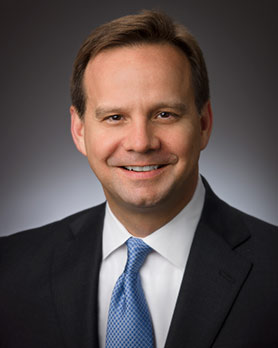2015 CEOs Who "Get It"
The National Safety Council recognizes nine leaders who demonstrate a personal commitment to worker safety and health

 |
 |
Brad Childers
President and CEO
Exterran
 |
Accomplishments
EXTERRAN is an industry leader in natural gas compression products and services – plus a premier provider of equipment solutions for petroleum production, gas processing, produced water treatment and aftermarket parts and services. The Houston-based company employs about 10,000 workers. |
Why is safety a core value at your organization?
Safety is a core value at Exterran because we believe that keeping our employees safe is the most important thing we do each day. My expectation is that my employees get to go home each night in exactly the same condition as they arrived to work. Safety is not about metrics. Safety is about saving lives, saving limbs and saving families.
Describe your journey to becoming a CEO who understands the importance of worker safety. What experiences or lessons brought you to where you are now?
I have worked in the oil field for 20 years. I have seen firsthand the impact that our business can have when safety is not Job One. It results in the loss of life, which I have experienced, and in the loss of limbs and in the loss and impairment of the ability to provide for one’s family, and to live a fully enabled life. Making the decision that we must do all we can to save lives and provide a safe environment became the only choice in the face of these risks. I choose to lead and emphasize a safe workplace; I want to meet with my employees in safety meetings and not see them in the hospital or meet broken families in the funeral homes.
What is the biggest obstacle to safety at your organization, and how do you work to overcome it?
The biggest obstacle to a safe workplace is leadership. It is all about leadership – leadership of oneself and leadership of one’s team. It is about ensuring we have penetrated into the core beliefs of each of our leaders, that safety is not an important thing, but rather that it is the main thing. It’s about capturing the criticality of safety in the heart in order for that strong, ingrained belief to translate securely and consistently into the mind, hands and feet. It has to become a focus and a habit.
How do you instill a sense of safety in employees on an ongoing basis?
Workplace practices are all about routines. With the right routines, the organization can keep the important objectives front and center, in our sights and in our minds. Safety is no different. Having provided our employees with the right training, tools, procedures and the right to always stop the job in the event of an unsafe condition, awareness requires that we have the right periodic focused discussions, trainings and workshops around safety. At our company, every operating meeting starts with a safety moment, just as every operational work activity starts with a job hazard assessment. It is our way of consistently communicating our value – safety first.
How does your organization measure safety? What are the leading indicators that show you how safe your organization is, and where do you see room for improvement?
The primary metrics we use to measure safety include both leading indicators and the historical trailing indicators. On the leading indicators, we use observation cards and the successful tracking, fixing and eliminating the conditions that give rise to the observations. Our focus here is not necessarily on the number of cards, but more so on the actions to close the card. That closure creates a strong reinforcing loop that builds upon itself. The next level of improvement for our organization will be to focus much more on the leading indicators. By this we aim to have the organization preventing incidents rather than just reporting on them.
Additionally, and as I noted previously, safety is not just about metrics. So an important part of how we try to get in front of safety is our regular management reviews of HSE at the corporate, division and regional levels. In these reviews we are able to get inside the organization as we look at progress on our long-term strategic HSE plan, annual HSE plans, audit action closures and other similar items. All of this gives us a much better view of how well we are really doing and how well our culture is maturing. This also enables us to target some specific areas that need improvement.
What advice would you offer to other leaders whose organizations are at an earlier stage of the journey to safety excellence?
- Do not underestimate the importance of safety performance. Saving lives, saving limbs and saving families is a high calling.
- Do not underestimate the cost of poor safety performance. In terms of morale and profitability, it may be the best investment your enterprise will ever make in its people.
- Get out in the field, be the ambassador, consider it a mission and a missionary journey to help keep your employees safe.
What advice would you offer to a safety professional whose CEO doesn’t “get it”? How can safety pros secure buy-in from the C-Suite?
I would suggest to a safety professional whose CEO doesn’t get it, be sure not just to report statistics and show graphs. You have to find a way to unravel all that in a way that strikes a chord with your CEO. Rather, take your CEO out into the field and have him or her engage in the activity that gives rise to the risks. Have him or her actually sort through safety observation cards and discuss the ideas that result in the resolution, in the role of a line employee. And I would definitely have the CEO involved in all incident reporting at the appropriate level. It is the hands-on actual dealing and managing the incidents, the facts and the hurt bodies and lives that bad safety performance can risk that will tangibly demonstrate the mission criticality of great safety practices.
Post a comment to this article
Safety+Health welcomes comments that promote respectful dialogue. Please stay on topic. Comments that contain personal attacks, profanity or abusive language – or those aggressively promoting products or services – will be removed. We reserve the right to determine which comments violate our comment policy. (Anonymous comments are welcome; merely skip the “name” field in the comment box. An email address is required but will not be included with your comment.)

